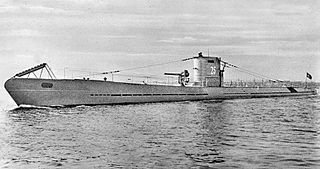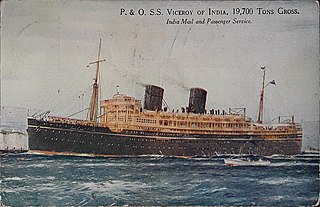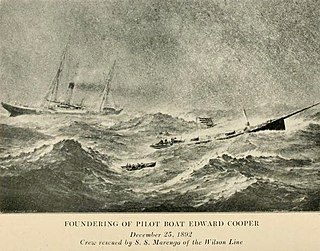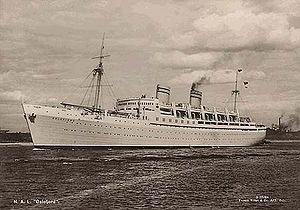
RMS Transylvania was a British Ocean Liner. She was launched on 11 March 1925 for the Anchor Line and was the sister ship to the SS California, and RMS Caledonia. She was converted into an armed merchant cruiser, pennant F56 during World War II. On 10 August 1940, HMS Transylvania was torpedoed and sunk by the German U-boat U-56.

CP Ships was a large Canadian shipping company established in the 19th century. From the late 1880s until after World War II, the company was Canada's largest operator of Atlantic and Pacific steamships. Many immigrants travelled on CP ships from Europe to Canada. The sinking of the steamship RMS Empress of Ireland just before World War I was the largest maritime disaster in Canadian history. The company provided Canadian Merchant Navy vessels in World Wars I and II. Twelve vessels were lost due to enemy action in World War II, including the RMS Empress of Britain, which was the largest ship ever sunk by a German U-boat.

Deutsche Schiff- und Maschinenbau Aktiengesellschaft was a cooperation of eight German shipyards in the period 1926 to 1945. The leading company was the shipyard AG Weser in Bremen.

German submarine U-25 was one of two Type IA ocean-going submarines produced by Nazi Germany's Kriegsmarine. Constructed by DeSchiMAG AG Weser in Bremen as yard number 903, U-25 was commissioned on 6 April 1936. It experienced a short, but successful combat career, sinking eight ships and damaging one.

RMS Viceroy of India was an ocean liner of the Peninsular and Oriental Steam Navigation Company (P&O). She was a British Royal Mail Ship on the Tilbury–Bombay route and was named after the Viceroy of India. In World War II, she was converted to and used as a troopship. She was sunk in the Mediterranean in November 1942 by German submarine U-407.
German submarine U-30 was a Type VIIA U-boat of Nazi Germany's Kriegsmarine that served during World War II. She was ordered in April 1935 in violation of the Treaty of Versailles, which prevented the construction and commissioning of any U-boats for the German navy, and as part of the German naval rearmament program known as Plan Z. She sank the liner SS Athenia (1922) on 3 September 1939, under the command of Fritz-Julius Lemp. She was retired from front-line service in September 1940 after undertaking eight war patrols, having sunk 17 vessels and damaging two others. U-30 then served in a training role until the end of the war when she was scuttled. She was later raised and broken up for scrap in 1948.

MS Oslofjord was a combined ocean liner/cruise ship built in 1949 by Netherlands Dock and Shipbuilding Company in Amsterdam, Netherlands for Norwegian America Line. As built she was 16,844 gross register tons, and could carry 620 passengers.
German submarine U-178 was a Type IXD2 U-boat of Nazi Germany's Kriegsmarine built for service during World War II.
Wahehe was a 4,690 GRT cargo ship which was built in 1922 as Wadigo by Reiherstieg Schiffswerfte und Maschinenfabrik, Hamburg for Woermann Linie AG. She was converted to a refrigerated cargo liner in about 1934.
German submarine U-64 was a Type IXB U-boat of Nazi Germany's Kriegsmarine during World War II. She was ordered by them in July 1937. Her keel was laid down by AG Weser in Bremen in December 1938. Following about nine months of construction, she was launched in September 1939 and formally commissioned into the Kriegsmarine in December.

German submarine U-104 was a Type IXB U-boat of Nazi Germany's Kriegsmarine during World War II. She was ordered by the Kriegsmarine on 24 May 1938 as part of the German naval rearmament program Plan Z. Her keel was laid down by DeSchiMAG AG Weser in Bremen in November 1939. Following about six and a half months of construction, she was launched on 25 May 1940 and formally commissioned into the Kriegsmarine on 19 August 1940.

German submarine U-67 was a Type IXC U-boat of Nazi Germany's Kriegsmarine that operated in World War II. She was laid down in the AG Weser yard in Bremen as yard number 986 on 5 April 1940. She was launched on 30 October and was commissioned on 22 January 1941 under Korvettenkapitän Heinrich Bleichrodt.

German submarine U-153 was a Type IXC U-boat of Nazi Germany's Kriegsmarine built for service during World War II. The keel for this boat was laid down on 12 September 1940 at the DeSchiMAG AG Weser yard in Bremen, Germany as yard number 995. She was launched on 5 April 1941 and commissioned on 19 July under the command of Korvettenkapitän Wilfried Reichmann.
German submarine U-860 was a long-range Type IXD2 U-boat built for Nazi Germany's Kriegsmarine during World War II.

The SS Runic was a steamship built at Harland and Wolff in Belfast for the White Star Line which entered service in 1901. Runic was the fourth of five Jubilee-class ocean liners built for White Star's Australia service along with her sister ship SS Suevic, where she ran on the Liverpool–Cape Town–Sydney route. She served this route until she was requisitioned for use as a war transport between 1915 and 1919, before returning to the Australia service.

The William J. Romer was a 19th-century pilot boat built in 1841 by John & James Friend for New York Pilots. She was considered one of the fastest pilot-boats out of New York. In 1846, the Romer sailed across the Atlantic on a special express trip to Liverpool, England. The Romer Shoal Light was named for the Romer, which sank there in 1863.

The Joseph Pulitzer was a 19th-century Sandy Hook pilot boat, built by Moses Adams in 1894 at Essex, Massachusetts for New York Pilots. She was a replacement for the Pilot Boat Edward Cooper, that sank off Sandy Hook in 1892. The Joseph Pulitzer was one of the finest and best equipped boats in the service. She was named in honor of Joseph Pulitzer, a New York newspaper publisher. In 1896, when New York pilot boats were moving to steamboats, she was sold to the Oregon Pilots Association.

The Edward Cooper was a 19th-century Sandy Hook pilot boat, built in 1879 for New York Pilots at Greenpoint, Brooklyn. She was named in honor of the Mayor of New York City. The Edward Cooper helped transport New York City maritime pilots between inbound or outbound ships coming into the New York Harbor. She survived the Great Blizzard of 1888. In 1892, the Cooper sank in a snowstorm and was replaced by the Joseph Pulitzer in 1894.

The Sandy Hook was a steam pilot boat built in 1902, by Lewis Nixon at the Crescent Shipyard in Elizabeth, New Jersey. In 1914, she was purchased by the New York and New Jersey Sandy Hook Pilots Association to replace the pilot boat New Jersey, that was lost in 1914. She could carry 10 to 12 pilots that would help guide ships through the New York Harbor. The Norwegian America Line Oslofjord, with the Crown Prince Olav of Norway and Princess Märtha of Sweden on board, ran into and sank the Sandy Hook in 1939.

Favorite or Favorita, was a 19th-century New York Sandy Hook pilot boat built in the early 1820s. She helped transport New York City maritime pilots between inbound or outbound ships coming into the New York Harbor. Favorite collided with a United States steamer and sank in 1865 near Barnegat Lighthouse.















